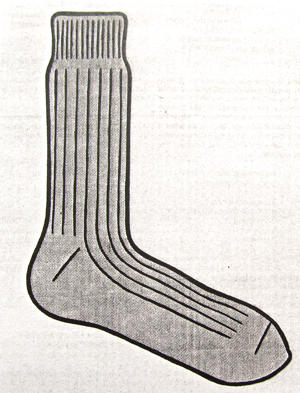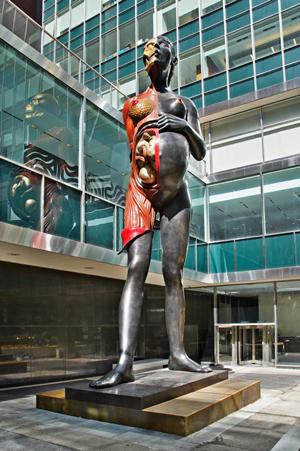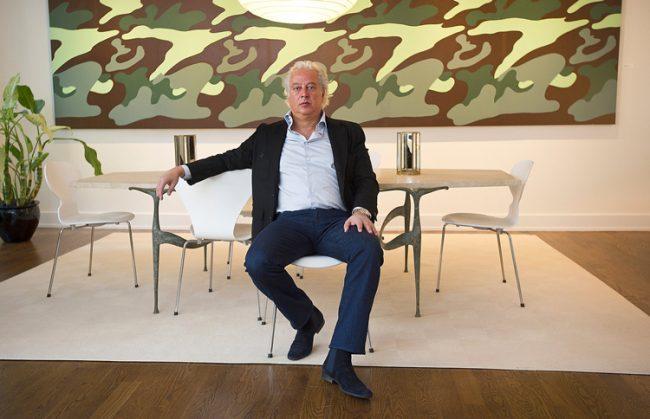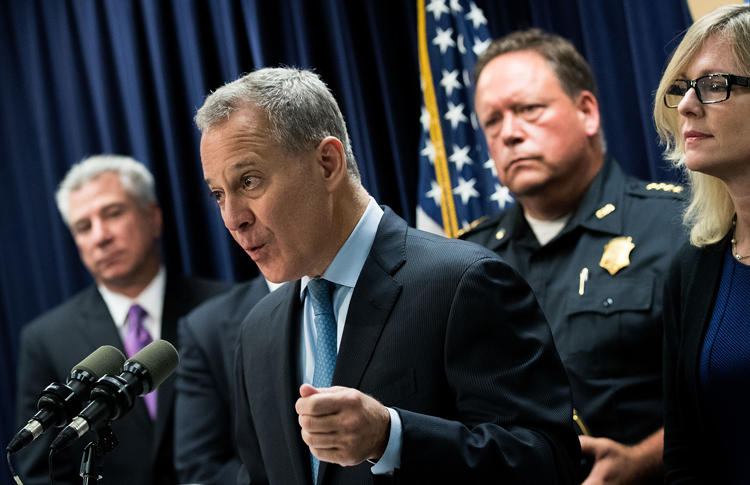It started with a single tip, furtively passed on to New York State Attorney General Eric Schneiderman’s office more than two years ago: A certain wealthy individual was buying big-ticket works of contemporary art, and systematically conspiring to evade state tax laws. These violations, the tipster suggested, were depriving the state of millions of dollars. Did the authorities want to know more?
The initial tip did not “pan out,” Schneiderman’s office told Luxury Listings NYC, but it did set in motion a wider investigation that has already resulted in a $7 million settlement with real estate developer Aby Rosen, a $4.3 million settlement with New York dealer Larry Gagosian and a $210,000 settlement with Gagosian Gallery sales executive Victoria Gelfand. More recently, in September 2016, the Manhattan District Attorney’s office unveiled a criminal indictment accusing another high-profile Manhattan developer, Michael Shvo, with tax fraud. More are likely to follow.
“It’s a very, a considerable effort,” said one official in the AG’s office, who declined to be named. “I can’t tell you about the active investigations. But there are other things in the works which we can’t talk about.”
The cases, which offer a look inside the rarified art world, are just the most recent example of what has emerged as an ongoing, decades-long cat-and-mouse game between wealthy investors and New York City and State tax authorities over the payment of taxes for luxury goods, most notably art. But some industry players say there may be reason to take this particular crackdown more seriously than past efforts. It is a matter of timing, occurring as the art industry faces greater scrutiny from federal law enforcement authorities, that, some suggest, seems only to be tightening.
“This indictment puts other purchasers
of fine art on notice.”
—Manhattan District
Attorney Cyrus Vance
All this comes as the art market, buffeted in 2016 by global events such as the turbulent U.S. presidential election, Britain’s “Brexit” vote and China’s cooling economy, still saw some record sales at auction, including the recent sale of Claude Monet’s 1891 “Grainstack,” which went for $81.4 million with fees at Christie’s in Manhattan. The sale highlights the very different nature of the art market from other types of investments — it is far riskier, sensitive to booms and busts, and tough for novices to navigate, as art dealers are not subjected to the same sort of statutes that prohibit, for example, stockbrokers and financial advisers from deception and misrepresentation.
“The state crackdown always has to do with money and people not [paying] sales tax — and you know the state needs the money,” said Asher Edelman, a financier who is also a major collector and dealer of contemporary art, who owns the gallery Edelman Arts in Gramercy. “But I think this is for real this time. It’s been the Wild West because there’s no transparency in this business. There has been so much fraud and gouging and tax evasion and money laundering attached to this business. There’s a bigger issue.”
Federal authorities are becoming increasingly active in the area, he noted, “getting their feet in,” and are beginning to look “pretty carefully at auction house practices, not just tax practices, but… across the board for what’s going on in this art business.”
***
The state AG’s office is empowered to investigate tax violations in the art world under a law known as “the False Claims Act,” which is designed to discourage people from defrauding the government. Most states and the federal government have similar statutes aimed specifically at weeding out fraud in project procurement, grants or services provided to the state. But the New York law is one of the few that also permits the government or whistleblowers to bring claims against tax cheats in the art world. Any whistleblower who successfully files a claim is potentially entitled to 15 to 35 percent of the settlement amount. And the state is permitted to levy punitive damages up to triple the amount owed.

Aby Rosen paid $5.25 million in 2011 for Roy Lichtenstein’s “Sock.”
There’s a lot of money at stake. The aggregate sales tax in New York City is 8.875 percent (state, city and Metropolitan Commuter Transport District), which can amount to tens of millions of dollars in lost revenue when taxes on luxury goods are avoided.
The core of the AG’s current offensive is focused on several key methods of tax evasion, including the abuse of a sales tax exemption that exists for art dealers who intend to resell the paintings they purchase, and the fraudulent use of an exemption that allows consumers to avoid paying the state sales tax by shipping luxury goods out of state.
Aby Rosen’s case highlights the first issue. Rosen is a German-born real estate tycoon who lives in New York City and owns numerous high-profile properties, including the Lever House and the Seagram Building (the former home of the Four Seasons, until Rosen declined to renew its lease). Rosen is also a major collector of modern art. His collection includes five Picassos, which he has displayed in his Manhattan home, and a $2.5 million, 33-foot-tall sculpture of a pregnant woman with an exposed fetus by Damien Hirst, which riled up the neighbors when Rosen installed it at his Old Westbury estate.
Between 2002 and 2015, New York State claims that Rosen, through his limited liability company 22nd Century Acquisitions, spent more than $80 million on more than 200 works of art, jewelry, furniture and other decorative items, and, with a single exception, paid no taxes on any of them, according to a court document that lays out the $7 million settlement between the state and Rosen. (Among the items in question: Andy Warhol’s “Howdy Doody,” purchased for $866,500 in 2011; Roy Lichtenstein’s “Sock,” bought for $5.25 million in 2011; and the Hirst sculpture, “Virgin Mother,“ for $2.5 million.)
Rosen avoided paying taxes by taking advantage of an exemption for art dealers who intend to resell the paintings they purchase. To do so, the buyer must obtain a “resale certificate” from the Department of Taxation and Finance, fill it out and give it to the vendor. This relieves the vendor of the obligation of charging sales tax. Yet after buying the works of art, Rosen displayed many of them at his real estate company, in family members’ offices and in his own home, which the AG’s office claims constituted a violation of the act.

Rosen’s provocative 33-foot-tall sculpture of a pregnant woman with an exposed fetus, created by Damien Hirst
In the second case involving a real estate figure, Manhattan District Attorney Cyrus Vance Jr., working with state investigators, accused the luxury broker-turned-developer Michael Shvo — who epitomized the go-go environment of the last real estate boom — of scheming to avoid paying more than $1 million in taxes related to the purchase of fine art, furniture, jewelry and a Ferrari.
Shvo did so, the DA claims, by telling auction houses he planned to ship the purchases out of New York State. He then had moving companies ship them to his New York offices and local homes instead and falsify their records, the DA claimed. The indictment also accuses Shvo of fraudulently using New York resale certificates to buy a number of items, including $65,000 in jewelry for his wife. Shvo could face a prison sentence of up to 15 years.
Defenders of Rosen and Shvo contend the two were simply caught up in a larger sweep, and were targeted because they are high-profile industry players sure to generate significant media attention. A 2013 New York Times profile paid careful attention to describing Shvo at his home in Manhattan (he has another in the Hamptons), “sitting in a bronze chair in his living room on the 68th floor of the Time Warner Center, surrounded by pieces of modern art.”
In his settlement, Rosen admitted no wrongdoing, claiming that the display of the artworks was “incidental” — that they were always for sale — and that, according to his understanding, he was operating within the law. He paid capital gains taxes on the artworks after they were sold.
Shvo’s criminal defense attorney, Benjamin Brafman, also attacked the charges.
“We believe that the indictment against Mr. Shvo is legally defective for a great many reasons that we intend to bring to the attention of the district attorney and, if necessary, litigate in court,” Brafman told LLNYC.
Rosen declined to comment. An attorney for Gagosian did not respond to calls seeking a statement.
Going after high-profile individuals like Shvo and Rosen is “an easy source of revenue for the state and the city, and also makes great headlines for both the AG’s office and the DA’s office,” said Thomas Danziger, managing partner at Danziger, Danziger, & Muro.
But some of the laws — even the ones that Rosen is accused of violating — are “more of a gray [area] than you think,” he argued.

Rosen shown with Andy Warhol’s “Camouflage,” in his office at 530 Park Avenue
Danziger said he is currently working with a number of clients to “keep them out of the newspapers.” And if the crackdown was intended as a warning to others, the message has certainly been received. “People are being very careful,” he says.
“Some people try to avoid paying tax because they don’t like to pay tax,” he added. “But other people are legitimately confused by the regulations and don’t understand what’s required. The current regulations are sufficiently murky that it’s difficult for practitioners in the area to explain to their clients what is required.”
Marion Maneker, publisher of the blog Art Market Monitor, said the practice described in these cases is widespread.
“It’s not an uncommon behavior in New York for people buying all sorts of luxury goods to have the box sent out of state and then bring it back in, which is a violation of the law,” Maneker said. “And the fact that everybody does it and winks at it is exactly the type of thing that prompts the state to make an example and say ‘it’s not okay.’ This was just another way of reminding people that there is a sheriff in town and they don’t like this type of behavior.”
In order to win a case, the state must demonstrate “intent” on the part of the person violating the law, either through willful tax evasion or “deliberate ignorance,” which caused him to “act in reckless disregard of the falsity of the statements that they were making.”
“Reckless disregard is not negligence,” said a source in the AG’s office. “You can’t be tagged with a violation of this act for making a mistake.”
This, the AG’s office said, was true in the case of Rosen, who claimed that everything was for sale but didn’t have a gallery and put the art in his homes and office, “even in the men’s room and the conference rooms.”
Some wealthy investors say there may be reason
to take this particular crackdown
more seriously than past efforts.
Shvo, DA Vance said in announcing the indictment last September, “went to great lengths to defraud New Yorkers out of more than a million dollars in revenue.”
The indictment claims that court documents and statements made on the record prove Shvo engaged in a “long-term scheme to evade payment of state and local sales and use tax on purchases of fine art, furniture, and jewelry.”
Shvo informed auction houses and art galleries that his purchases would be shipped to an out-of-state address in the Cayman Islands or other overseas destinations. Instead, he had them shipped to his office, his apartment on Columbus Circle and a house in the Hamptons. The DA accused two individuals from shipping companies, Hedley’s and BestGuy Moving, of providing auction houses and galleries with fraudulent shipping documentation, deliberately misrepresenting the destination of the purchases. Meanwhile, Shvo was accused of fraudulently using New York Resale Certificates to, among other things, buy jewelry valued at more than $65,000 for his wife and furniture for his office in New York.
Shvo, the indictment states, also evaded payment of New York State and local use tax on a new Ferrari 458 Spider, which he purchased from an out-of-state dealer. To do so, he registered a limited liability company in Montana and registered the luxury vehicle to the company. But no business was ever conducted in Montana, and the vehicle was used in New York.
The DA’s office declined to discuss the Shvo case, noting that it is an ongoing matter. But Vance and his office have made it clear that the intent is to send a message.

Andy Warhol’s “Howdy Doody,” purchased for $866,500 in 2011
“This indictment puts other purchasers of fine art on notice,” Vance said when he announced the case.
The state wants to send a similar message. An official in the AG’s office noted that in any negotiation between a seller and a buyer of a big-ticket item, a buyer obviously wants to pay as little possible, and a seller wants to make as much as possible.
“The only entity not in the room when that calculus is being worked out is the state and city to whom taxes are owed. So we see a variety of situations in which the state doesn’t get its share,” the official told LLNYC. “We want everybody in that industry to know that we are watching. And that the state sort of is in the room, or at least comes into it after the transaction is done.”
Art industry veterans say major tax fraud crackdowns go back at least to the mid-1980s. Around that time, state tax authorities indicted executives at several luxury jewelry and fur stores in Manhattan, accusing them of helping clients evade taxes by mailing empty boxes to fake out-of-state addresses. The crackdown culminated with a $5 million fine against Van Cleef & Arpels and guilty pleas from the company’s president and controller, who admitted sending empty boxes to out-of-state addresses for wealthy customers, including Imelda Marcos and Leona Helmsley.
But state authorities didn’t stop there. In 1986, state investigators went from store to store and found that 12 percent of the retail businesses they visited in Midtown Manhattan and four upstate cities cheated on taxes, according to a New York Times story. The retailers included jewelers, restaurants and clothing shops — and even a tire outlet, umbrella store and pizzeria.
Such crackdowns have a history of yielding financial results. In 2004 testimony before the Congressional Committee on Senate Finance, Robert Morgenthau, then the Manhattan DA, noted that over the course of two years, his office had collected $24.6 million in back sales taxes and fines in the fine art industry alone, but considered that figure a low estimate. The actual total of back taxes paid as a result of the investigation may have exceeded four times that amount, he said.
And indeed, most observers believe the current investigation is likely to have a similar hard-hitting financial impact.
Tracking and going after art buyers cheating the system has never been easier, said Ralph Lerner, a 40-year veteran art adviser and art attorney, thanks to art gallery databases and the ability to cross-reference buyers’ names with tax filings, which reveals where customers paid taxes on the items or if they avoided doing so all together.
To tighten the noose, the state often sends letters to individual gallery clients who shipped purchases out of New York asking them to sign a piece of a paper under penalty of perjury attesting to the fact that the items still remain there.
“It’s one thing to go ahead and say ship it to my storage place in Delaware, and it’s another thing to sign a piece of paper under penalties of perjury where they ask you where is it,” Lerner says. “It raises the stakes for anyone who signs that piece of paper.”
Lerner said the concept of tax evasion has always perplexed him.
“I always used to say to people, ‘you’re wealthy enough to buy a $10 million item. What are you doing? Pay the goddamned tax!” He says. “It’s a psychology of people, it doesn’t matter how rich they are. It’s a little bit on the bizarre side, they just come up with a scheme. It never made any sense to me.”
Although in the past crackdowns have come and gone, some argue that this time the increased scrutiny is likely here to stay, meaning fraud is far less likely to avoid detection — especially for big-ticket items, especially as the problem draws attention across international borders.
In recent months, another high-profile legal dispute has drawn attention to the opacity of the art world and the capacity the art market has for money laundering and price manipulation. The dispute involves art collector Dmitry Rybolovlev, a Russian fertilizer oligarch and owner of super pricey real estate in NYC and around the world, and Yves Bouvier, an art world titan who runs duty-free storage facilities from Geneva to Singapore. In court documents, Rybolovlev has accused Bouvier of overcharging him $500 million to $1 billion during the course of a decade for works by Mark Rothko, Leonardo da Vinci and Pablo Picasso.
Last March, Bloomberg reported that U.S. Justice Department prosecutors were examining various art deals Bouvier struck on behalf of other clients.
Soaring prices and secrecy in the art world — as well as the lack of regulation surrounding major transactions — have in recent years brought allegations that collectors and dealers use prized works to launder money, dodge taxes and defraud purchasers and investors. In China, Switzerland and across Europe, governments have all begun to examine the ways major art collections are used to hide ill-gotten wealth and avoid taxes.
Gary Wolfe, a West Coast attorney and tax expert, noted that in the U.S., federal authorities are taking away the anonymity of LLC companies buying real estate. A pilot program launched in January 2016 requires title insurers in Miami-Dade County and Manhattan to identity the owners of LLCs that paid all cash for homes priced above $1 million in Florida and more than $3 million in Manhattan. The order was expanded in July 2016 to encompass all of South Florida, chunks of California and Texas, and all five of NYC’s boroughs. It’s only a question of “when” it goes nationwide, and the effort is expanded to art, cars and planes, he said.
“I think that a lot of the art market is subject to money laundering,” Wolfe said. “I’ll give you a quote from my favorite Nobel Prize winner, Bob Dylan, for all these people who think they can keep cheating: ‘it’s all over now baby blue.’”
Some are even counting on vigorous scrutiny as a part of doing business now. Edelman, the collector, noted that he is about to receive a large payment on a number of artworks he recently sold to a sovereign state collection. He expects the purchase to draw the attention of the Department of Homeland Security or other federal investigative agencies.
Three to six months from receiving payment, Edelman expects federal authorities “are going to come in and start ripping my account apart,” he said, asking questions about money laundering. “They’re being very careful. They have a lot of manpower these days. And one has to abide by the rules.”
